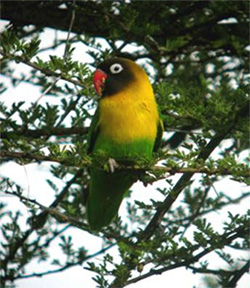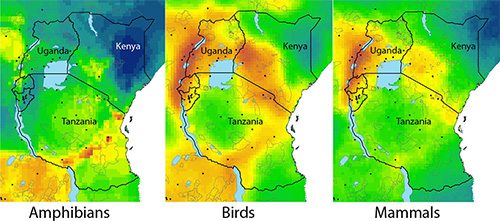Biodiversity Maps Developed by UC San Diego Scientists Will Help to Guide Conservation Measures in East Africa
July 7, 2008
By Susan Brown
Conservation biologists from UC San Diego are collaborating with scientists from the African Conservation Centre and other institutions to map patterns of biodiversity and land use in East Africa in unprecedented detail. Their maps, combined with climate models, will project how climate change will alter biodiversity and help to shape policy for setting aside conservation easements.

Yellow-collared lovebirds stay local with one of the smallest ranges among East African birds.
Photo Credit: Jetz lab/UCSD
Wildlife, people and livestock have weathered past variation in climate by shifting their seasonal migration patterns though the varied of ecological zones in the Great Rift Valley, which runs through the center of Kenya and Tanzania.
"When you go from the bottom of the rift, it's almost desert. By the time you get up to the top, no more than 15-20 km away, it's rainforest," said David Western, adjunct professor of biology at UCSD, director of the African Conservation Centre in Nairobi and former director of Kenya Wildlife Service. "Previously this was communal land where people moved with the seasons and they moved with changing climates."
Now, as climate change is expected to shift the balance between habitats in this region, increased farming has fragmented the landscape, Western said. "It's removed the highland grazing for both livestock and wildlife. The crop residues can keep the livestock going, but it's a complete lockout for wildlife."
The project will identify areas that, if protected, would allow both wildlife and pastoralists to move to more favorable conditions as climate shifts. "What we want to do is identify key pathways where, working with landowners, you can actually keep the land open, through a conservation easement," Western said.
To determine how the centers of biological richness are likely to shift, UCSD biology assistant professor Walter Jetz and Daniel Kissling, a postdoctoral fellow, have mapped the ranges of 2,700 species of birds, mammals, amphibians and reptiles across all of Kenya, Tanzania, Uganda, Rwanda and Burundi.

Hot and cool spots for biodiversity emerge from overlapped ranges of all East Africa's amphibians, birds and mammals.
Photo Credit: Jetz lab/UCSD
For each species, they have plotted an 'ecological envelope.' "Within those boundaries, we are likely to encounter those species," Jetz said. "With the distribution map, we can determine the species' climatic niche."
The next step, Jetz said, is to revise their maps using satellite images and field notes, to a finer scale. Their current maps are drawn to a 100 kilometer resolution. "You need some refinement if you want to be able to make predictions, so we are taking global maps and refining them to the scale of actual conservation decision-making: to a 10 or 20 km resolution," Jetz said.
Jetz's group's maps of animal diversity will be combined with those for plants and human land use to gain a fuller picture of how ranges and interactions between species are likely to shift under different climate changes. A plant and an animal may respond differently to the same climate shift, for example, causing their ranges to diverge until the two species no longer co-exist.
At a recent meeting at the University of York in the UK, participants in the project agreed to join their completed distribution maps in a single database, and to combine that multilayered map with two climate models – one based on the minimum expected change and another that anticipates larger climate shifts ‐ to develop six future ecological scenarios for East Africa: two each for the years 2025, 2055 and 2085. These scenarios will inform decisions about setting aside additional reserves in Kenya and Tanzania.
"The organization David Western represents has close ties to the stakeholders in Kenya, and therefore there is hope that some of the findings will actually be implemented," Jetz said. "We sense a clear willingness in Kenya and Tanzania to put more reserves in place to mitigate the impacts of global change. For that they are looking to scientists for guidance. So we have a situation where good science can lead to significant basic insights and also make a difference for the people and their wildlife. We are very excited to be involved.
The project is funded by the Liz Claiborne Art Ortenberg Foundation. Other participating institutions include the Missouri Botanical Garden; the University of York, UK; and Clark University.
Related Content:
Africa Conservation Centre
